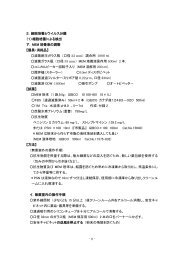Program and Abstracts(PDF)
Program and Abstracts(PDF)
Program and Abstracts(PDF)
Create successful ePaper yourself
Turn your PDF publications into a flip-book with our unique Google optimized e-Paper software.
Poster presentation 21<br />
HOW DO WE REDUCE THE IMPACT OF GLOBAL WARMING ON<br />
AQUACULTURE?<br />
-An introduction to projects to develop methods to counter the impacts of global warming-<br />
Tadashi, Andoh 1* , Hiromi Oku 2 , Naoto Murakami 1 , Norio Shirafuji 1 , Yoshitomo Nagakura 3 ,<br />
Hiroyuki Okouchi 4 , Yoshinori Sotoyama 5 , Saichiro Yokoyama 5 , Shunsuke Koshio 5 , Masafumi<br />
Amano 6 , Hiroshi, Hashimoto 7 , Kentaro Oda 7 , Yoshitsugu Masuda 7 , Hitoshi Imaizumi 7 , <strong>and</strong><br />
Hironori Usuki 7<br />
1 Akkeshi station, Hokkaido National Fisheries Research Institute, Fisheries Research Agency,<br />
Japan<br />
2 Nikko station, National Research Institute of Fisheries Science, Fisheries Research Agency,<br />
Japan<br />
3 Miyako station, National Center for Stock Enhancement, Fisheries Research Agency, Japan<br />
4 Agriculture, Forestry <strong>and</strong> Fisheries Research Council, Ministry of Agriculture, Forestry <strong>and</strong><br />
Fisheries, Japan<br />
5 Faculty of Fisheries, Kagoshima University, Japan<br />
6 School of Marine Biosciences, Kitasato University, Japan<br />
7 Shibushi station, National Center for Stock Enhancement, Fisheries Research Agency, Japan<br />
* E-mail: <strong>and</strong>oh at fra.affc.go.jp<br />
Global warming will have a big impact on aquaculture. A rise in water temperature could<br />
result in a variety of negative effects, such as: reduced food conversion efficiency due to a rise<br />
in catabolic activity, asphyxia due to low dissolved oxygen, <strong>and</strong> an increased risk of infectious<br />
diseases due to high temperature stress. Techniques to reduce the impact of global warming<br />
on aquaculture of marine fish are underway. An initial step has been clarification of the<br />
relationship between growth <strong>and</strong> temperature in each species. The second step has been<br />
quantitative <strong>and</strong> qualitative analyses of bodily <strong>and</strong> organ functions at high temperature. The<br />
third step has been estimations of individual variations in physiological status <strong>and</strong> growth at<br />
high temperature. The physiological characters for four marine fishes (flounder, sea bream,<br />
yellowtail <strong>and</strong> herring) at high temperatures have been analyzed to date. The results indicate<br />
that the temperature for maximum growth in each species is higher than that of the area where<br />
the species occurs naturally <strong>and</strong> that the variation in individual growth rate at high<br />
temperature is wider than at each species natural temperature. Notably, some individuals were<br />
even recorded showing growth close to the survival temperature limit. Selection <strong>and</strong> breeding<br />
of individuals for the ability to grow sufficiently at high temperature will be an important<br />
measure to counter the effects of global warming on aquaculture.<br />
88



